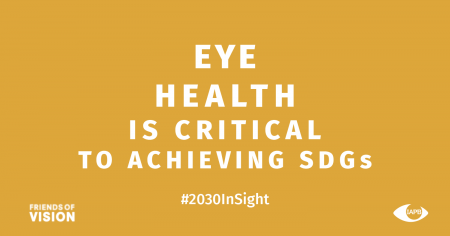23 Jul, 2021

Eye health is critical to achieving the SDGs #2030InSight
Credit: IAPB/UN Friends of Vision
Peek Vision has joined the global eye health community in welcoming the United Nations General Assembly (UNGA)’s adoption of the first agreement designed to tackle preventable sight loss. The ‘Vision for Everyone; accelerating action to achieve the Sustainable Development Goals (SDGs)‘ Resolution enshrines eye health as part of the UN SDGs and commits the international community to eye care for the 1.1 billion worldwide people living with preventable sight loss by 2030.
The resolution was passed unanimously by all 193 countries of the United Nations. It sets a target for vision for everyone by 2030, with countries set to ensure full access to eye care services for their populations, and to make eye health part of their nation’s journey to achieving the SDGs.
Welcoming the news, Dr Andrew Bastawrous, Peek Vision Co-Founder and CEO, said: “Vision and eye health are important accelerators of the Sustainable Development Goals. It’s extremely encouraging to see the importance of vision and eye health recognised by the UN General Assembly, and elevated beyond the confines of ‘health’ to their rightful place as contributors to improved education, prosperity, wellbeing, safety and equity.
“We are seeing our sector emerge from a focus on specialism to universal relevance, which will drive demand for eye health services, including increased uptake in schools, work places, as part of general health provision and beyond. Technology will play a vital part in helping to meet these demands and increase reach and access to services to those who need them most.
“Peek’s partnership with the Government of Botswana to deliver a national school eye health programme has demonstrated what is possible with committed national leadership. I congratulate the Government of Botswana, and the other countries who co-sponsored this UN resolution alongside them. Now is the time for the global community to work together to ensure these commitments become a reality.”
Sight loss is calculated to cost the global economy $411bn in productivity each year. The resolution creates new expectations for international financial institutions and donors to provide targeted finances, especially to support developing countries in tackling preventable sight loss. And for the United Nations to incorporate eye health into its work, including through Unicef and UN-Women.
It also calls for new targets on eye care to be included in the UN’s Sustainable Development Goals at its next review.
The plan will mean that by 2030, the 1.1 billion people globally living with untreated sight loss, will have access to support and treatment. But, campaigners say, only if governments and international institutions act now to fulfil their new commitments.
H.E. Ambassador Aubrey Webson, Permanent Representative of Antigua and Barbuda to the United Nations, and founding co-chair of the United Nations Friends of Vision group said: “An eye test for a child can be the difference between inclusion and or exclusion; A pair of prescription glasses, the difference between access to information and seeking a livelihood and not. Corrective eye treatment, the difference between improved sight and total loss of sight. The gift of sight for the 1.1 billion people living with preventable sight loss is within reach if we ensure world leaders deliver on this moment.”